Sounds of Now Vienna 2025
Now and Then
An aura of history hangs over Vienna: a landscape of Habsburg splendour, the mythical and consumptive presence of the great representatives of both Viennese Schools gazing down on passersby from the pedestals of bronze monuments or the plastic of souvenir shops. Centuries-old walls indifferently absorb the scorching heat from the sky by day and equally dispassionately return it to the air at night, trapping residents in a 24-hour August oven. The Universität für Musik und darstellende Kunst Wien (MDW)’s closed-windows policy, while allowing neighbours to lead lives free from the 12-hour cacophony that emanates from every music university and school, doesn’t exactly work well with the weather. But even without the heat, crossing the university’s threshold can be breathtaking. Although the building on Anton Webern Square is new, MDW’s rich past and alumni list, which somewhat resembles music history textbooks, create the atmosphere of History and the Great Musical Traditions.
And maybe that’s why it was all the more enjoyable to participate in Sounds of Now Vienna 2025, hosted at the MDW for the second time. Its friendly atmosphere and the energy and youth of the participants were like a gust of fresh air within the deep historic ambiance. The festival could perhaps even be called Sounds of Future, as it was clearly targeted towards the youngest generation of composers (the vast majority of participants were composers under thirty, a large part of whom were still students). Artists from the USA, Canada, New Zealand, Australia, and Asia (with a surprisingly scarce attendance of residents from Europe) flocked to the ancient capital of music. Their work in Vienna was however overseen by exceptional representatives of Now: composers (Lukas Ligeti, Dai Fujikura, Daniel Moser, Víctor Báez, and Adrián Artacho) and great performers (Ian Pace, Matthias Lorenz, Eric Lamb, Mivos Quartet, Ensemble Platypus, and Trio Immersio). All that, in an atmosphere of open minds and an unpretentious attitude, and in a small group of 20 residents, truly allowed me to focus on the Now, albeit with fond memories of Then.
Typical and unusual
Although the festival’s and courses’ structure followed the typical flow of composition workshops, personally, I felt that I was experiencing something new. I found myself in a rather rare situation for a critic: I wasn’t simply invited to observe the final results during the concert, but also to see behind the scenes. I could witness the whole process of creation, the detailed work with the compositions, the rehearsals, the discussions between composer and performer, and all the courses, workshops, and lectures, delving deep into the creative process itself. While probably a common occurrence for artists and teachers, it was somewhat unfamiliar territory for me. Although initially surprised by the hospitality of the SONV team, I quickly realised its importance. The Viennese festival is an interesting example of a musical event where the concert is not the most important part – all of them took place without fanfare, in a friendly, cosy atmosphere (and yet offered the opportunity to listen to such stars of contemporary music as Ian Pace, Eric Lamb or Mivos Quartet for free). If asked, each participant would likely point to a different festival highlight, but for me, the most spectacular things happened during the process.
While the composing masterclasses were typical, the rehearsals with (or rather rehearsals/workshops) proved surprising. Performers brought a lot to each piece, not only in terms of the performance (and that alone was really worth watching), but also in their subtle compositional work with the participants. Matthias Lorenz’s rehearsals were especially fascinating. The German cellist delves incredibly deeply into the score, meticulously analysing it, and even finding every detail the composer hadn’t thoroughly thought through. I sometimes couldn’t help but think he knew the composers’ intentions better than they did – and just as often, he was right. However, searching for solutions was never one-sided; it was a collaborative exploration. It was meticulous (but not mechanical) work and a thorough interpretation.
The lectures, on the other hand, transported me back to my student days. From extended techniques (Eric Lamb), through the noise of the piano key and its impact on timbre (Ian Pace) and the importance of notation for interpreting the score (Matthias Lorenz), to African traditions and the notion of movement in creating percussion arrangements (Lukas Ligeti), the topics varied and and remained consistently intriguing. However, the most interesting thing for me (a person with no teaching experience whatsoever) was observing the young composers working on their music, technique, and language at the earliest stages of their artistic development. At the very beginning, Now with the promise of Tomorrow.
Now, typical, and remarkable
It is pretty common for young artists, yet I am still surprised by how often they rely on intuition in their craft. A focus on timbres and sounds they like, extra-musical associations, and the multitude of ideas, may for many dominate over the work on preliminary planning, structural ideas, or a strictly intellectual approach. Having a very personal, emotional touch often makes it difficult for the composer to focus on a single idea or create a comprehensive narrative. Equally fascinating, however, is observing how rapidly even a small stimulus or hint from a teacher/performer is processed by the young artists, giving rise to new concepts, structures, narratives, and improved order. Their open-mindedness and the speed with which they absorb knowledge and generate ideas demonstrate their potential. Which, of course, develops and will continue to develop differently for each individual.
For some, the inspiration for the pieces presented at SONV stemmed from personal experiences. ShellEy (2025) for flute by Makenna Graham guides the listener through the process of learning to play the flute 1. The delicate, airy sounds and deliberate imperfections were beautifully brought to life by Eric Lamb, and the whole thing came together into an engaging miniature with a logical narrative and structure (although the scenographic elements were, in my opinion, unnecessary). Yvonne New dedicated her Ballooning (2025) for violin, viola, cello, double bass, and piano to her father, a lover of more traditional language. Eager to experiment with the avant-garde, the artist sought more euphonic sounds throughout the piece, albeit slightly distorted with a more modern articulation, harmonies, and techniques. The lilting melody wandered between instruments but remained somewhat frozen—as if the composer wasn’t entirely sure how to develop it.
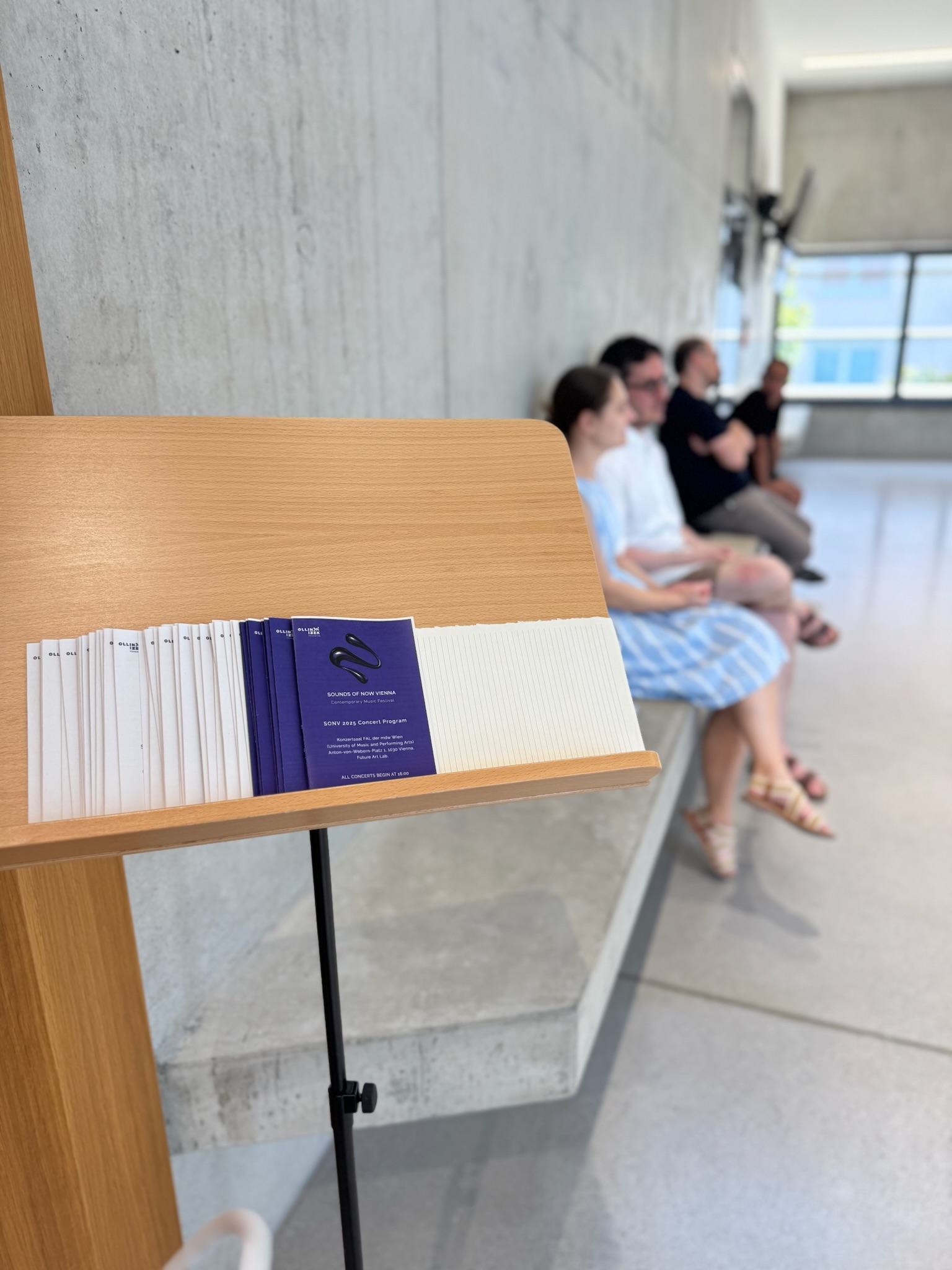
SONV 2025, photo: MJ Báez
The young artists also discussed social issues. Negar Gharibi’s Shear (2025) for string quartet addressed the issue of migration. Nevertheless, I couldn’t relate the declared program with the piece’s rather transparent airy texture and structural chaos – temporality? Transience? The protagonist of Ky Nam Nguyen’s Pour Henriette (2025) for piano was Henriette Bùi Quang Chiêu, the first female medical doctor in Vietnam and the first Vietnamese woman to earn a medical degree in France. This musical sketch in ABA form, full of Romantic inspirations, sounded rather mournful, even at times reminiscent of some famous 19th-century marches funèbres – albeit with a variable meter and a free pulse.
A feminist theme also appeared in Sonata for Solo Cello: Bone of her Bones (2025) by Sofya Bulatova, which tackled the issue of aggression towards Afghan women. The composer approached it by using traditional scales and incorporating a quote from a landay written by an Afghan woman 2 in Eliza Griswold’s translation:
In my dream, I am the president.
When I wake up, I am the beggar of the world.
The landay was written by a woman living near Jalalabad in a refugee camp.)) as a compositional framing device:
In my dream, I am the president.
When I wake up, I am the beggar of the world.
The music itself featured many interesting ideas. Some of them, however, seemingly came out of nowhere and led to no specific conclusion (such as the 8-bar melodic pizzicato motif, which stood out against the piece’s sonic background and wasn’t a musical quote). While I adore Matthias Lorenz’s playing and his flawless performance of the piece, perhaps it’s worth considering the expressive potential of inviting a female performer in the future?
Nature has been a constant inspiration for composers for centuries, and some residents followed the tradition: for example, Grace Wellik in her illustrative Blurred Light and Drifting Waves (2025) and Madeleine Bolz in Piano Trio No. 1 (2025), where the instruments emulated the rhythm of rain and a dialogue of sounds during a spring storm. On the other hand, Reid Contreras Woelfle painted a musical, not natural, landscape in Here and Then (2025) for piano trio. The raw space, the slow, gradual saturation of the sound with the taps of the instrument bodies and overtones, only to finally dry out to the mere col legno. It created an engaging narrative, even though quite traditional. It’s worth noting that SONV residents were particularly keen on using euphonic, diatonic, or even tonal language. And while every composer is said to have their own „diatonic phase,” I noticed a similar pattern during the Ostrava Days. A natural transitional stage, or already a trend?
In terms of more avant-garde language, the elements of instrumental theatre appeared popular. No less than three compositions drew on this idiom. They were also distinguished by maturity, humour, and well-thought-out structure. In Ben Marshall’s Rehearsal (2025) for bass clarinet, violin, viola, and double bass, each performer had a note attached to their back:
Paid to be here, want to be here;
Paid to be here, don’t want to be here;
Not paid to be here, want to be here;
Not paid to be here, don’t want to be here.
As the title suggests, everything resembled a rehearsal – the musicians practised fragments, counted the beats, corrected each other, moved around the room, and maintained non-concert body positions. They relaxed after each rehearsed „fragment.” All light and unforced. Just then, it occurred to me how much the performer’s body language conveys to the audience – when they are playing „seriously,” when they try things out, when the break is, when the piece ends; are they still tuning, or have they already started playing? As audience members, we often overlook this aspect as incidental rather than inherent to music, treating the musician’s body as almost transparent, especially in absolute music.
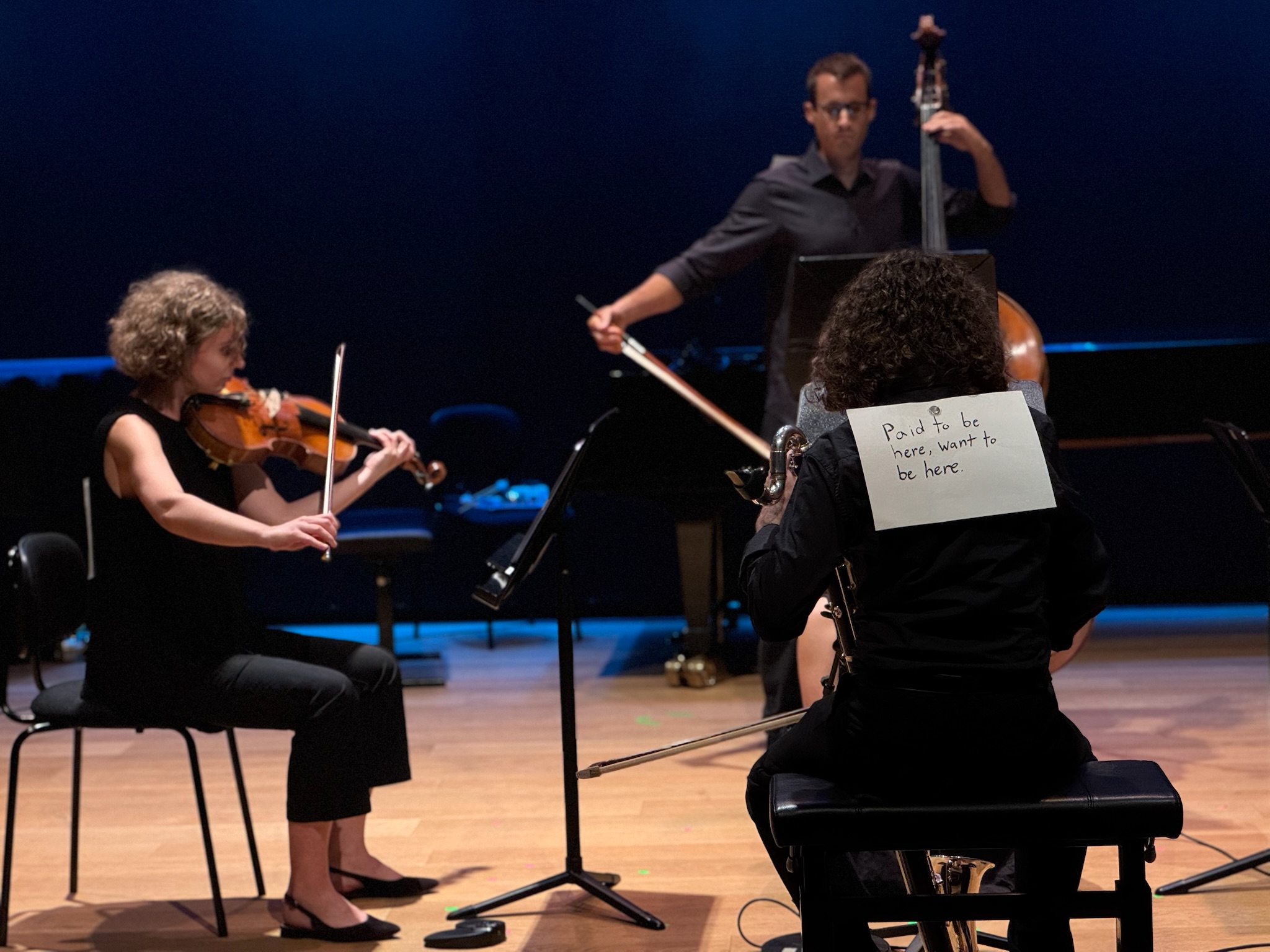
Ensemble Platypus, Ben Marshall Rehearsal, SONV 2025, photo: MJ Báez
Close to the notion of body, but stemming from a different perspective, was Evan Losoya’s Seb was here (2025). It revolved around linguistic convergence and the transformative relationships of (the words) sebum and soap. The performance included, for example, „washing hands” or rubbing them together. Without knowledge of the program, however, the performative aspect was somewhat unclear and ultimately unnecessary – the piece stood on its own solely in sonic terms. The skilful juxtaposition of noise, hum, and sound built an engaging narrative on its own.
In the final I love sextet but the sextet doesn’t love me (2025) by Wai Yau (William) Shiu, everything played out backwards – the musicians used instruments „the wrong way” – pressing the strings from the knot side, played with toothbrushes, with drumsticks on the piano, and with a thermos in the bell of the bass clarinet. A playful explosion of ideas, or a satire of the avant-garde? Regardless of the interpretation, the Hong Kong composer’s work, culminating in a great noise and performed brilliantly by Ensemble Platypus, was an excellent program choice to conclude the festival.
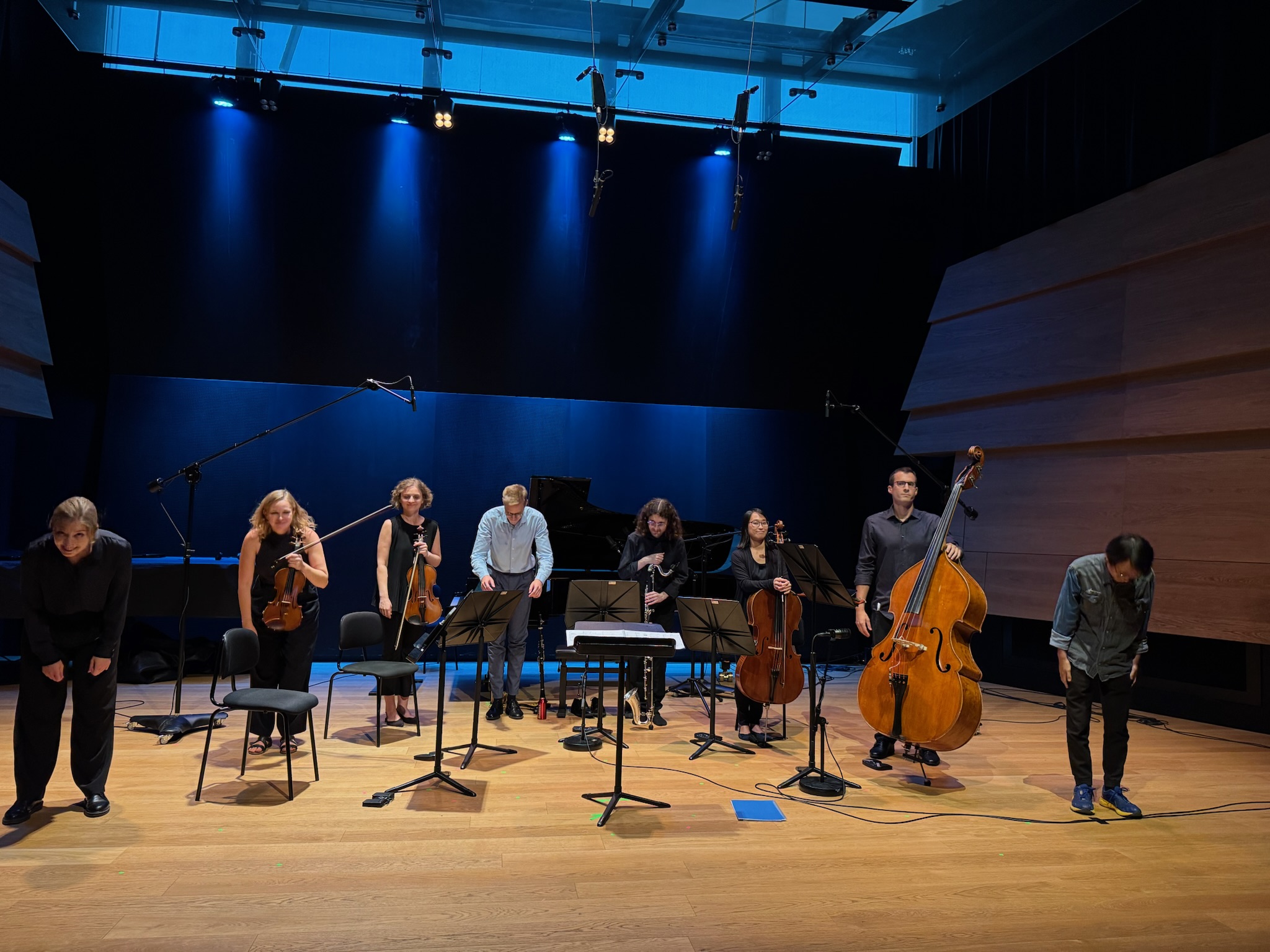
Ensemble Platypus, Wai Yau (William) Shiu I love sextet but the sextet doesn’t love me, SONV 2025, photo MJ Báez
The performative pieces, however, were not the only ones that stood out during the festival. Three other pieces by the residents proved particularly mature: Matteo Casado’s Difluencias (2025) for string quartet, Benjamin Zervigón’s Mother Water Ash (2025) for string quartet, and Miguel Segura’s Soliloquio No. 1 (2019, rev. 2023) for cello. The first of these, Difluencias (2025), proved to be an exceptionally coherent diptych with two contrasting movements. The first—heterophonic and motoric—continued to provide additional momentum with accentuation and articulation. The second developed a static texture with distinctive, prominent accents, which, like a reminiscence, bound the two movements into a coherent whole.
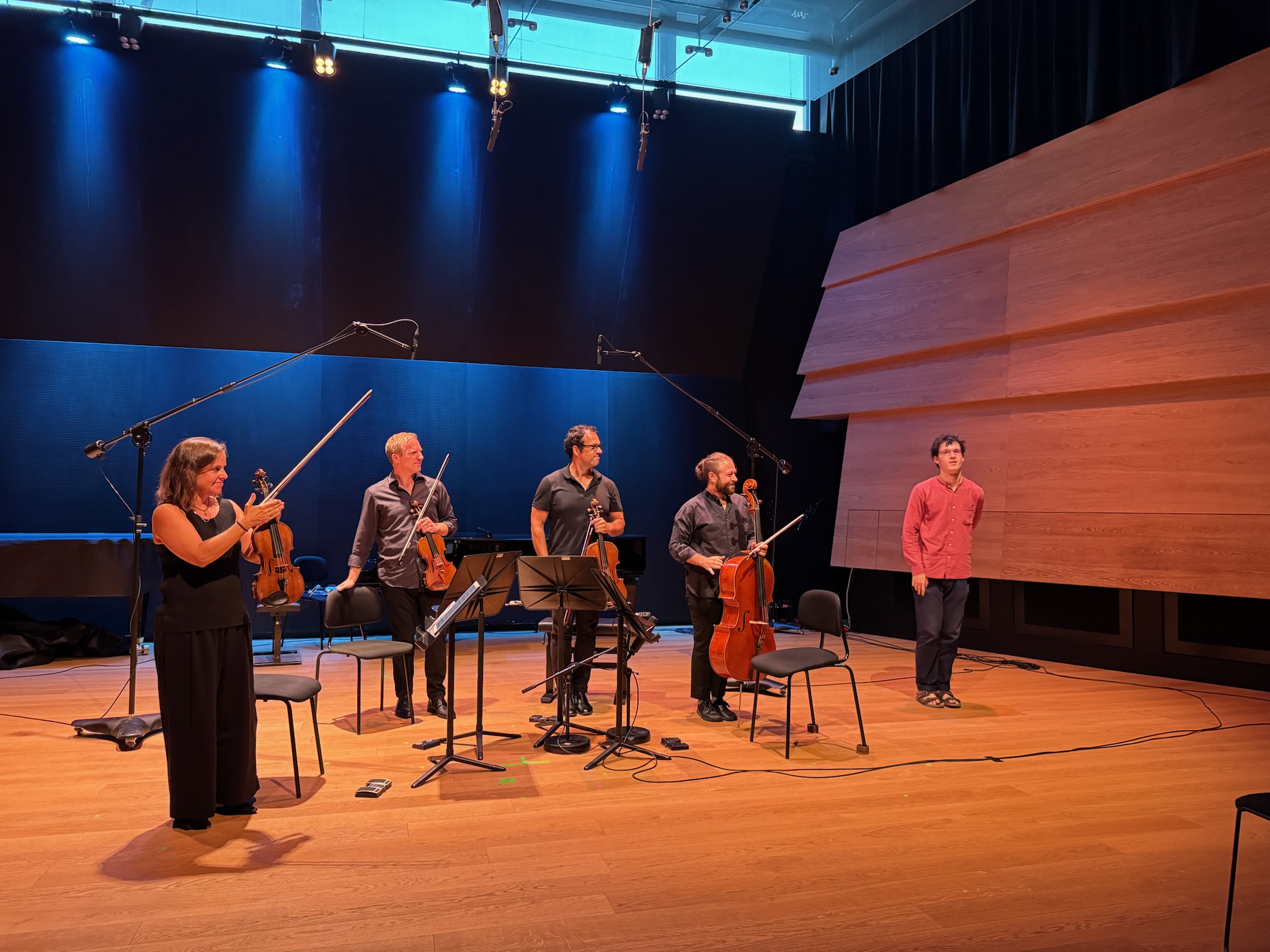
Mivos Quartet, Matteo Casado Difluencias, SONV 2025, photo MJ Báez
Zervigón’s piece, in turn, captivated me with its ephemeral quality. The melody, seemingly riddled with holes, stretched out to the point of breaking, even „drunk,” beguiled the listener. Along with the dissonant and sometimes microtonal harmony, which occasionally descended into a fleeting consonance, they led the listener through mirages of blurred memories. The performances of the brilliant Mivos Quartet added much color to both Casado’s and Zervigón’s pieces. The sombre atmosphere of Soliloquio stemmed from the relatively consistent handling of the dark timbre of the cello and structure. One also shouldn’t overlook the many great technical and interpretational ideas Matthias Lorenz brought to life in the piece.
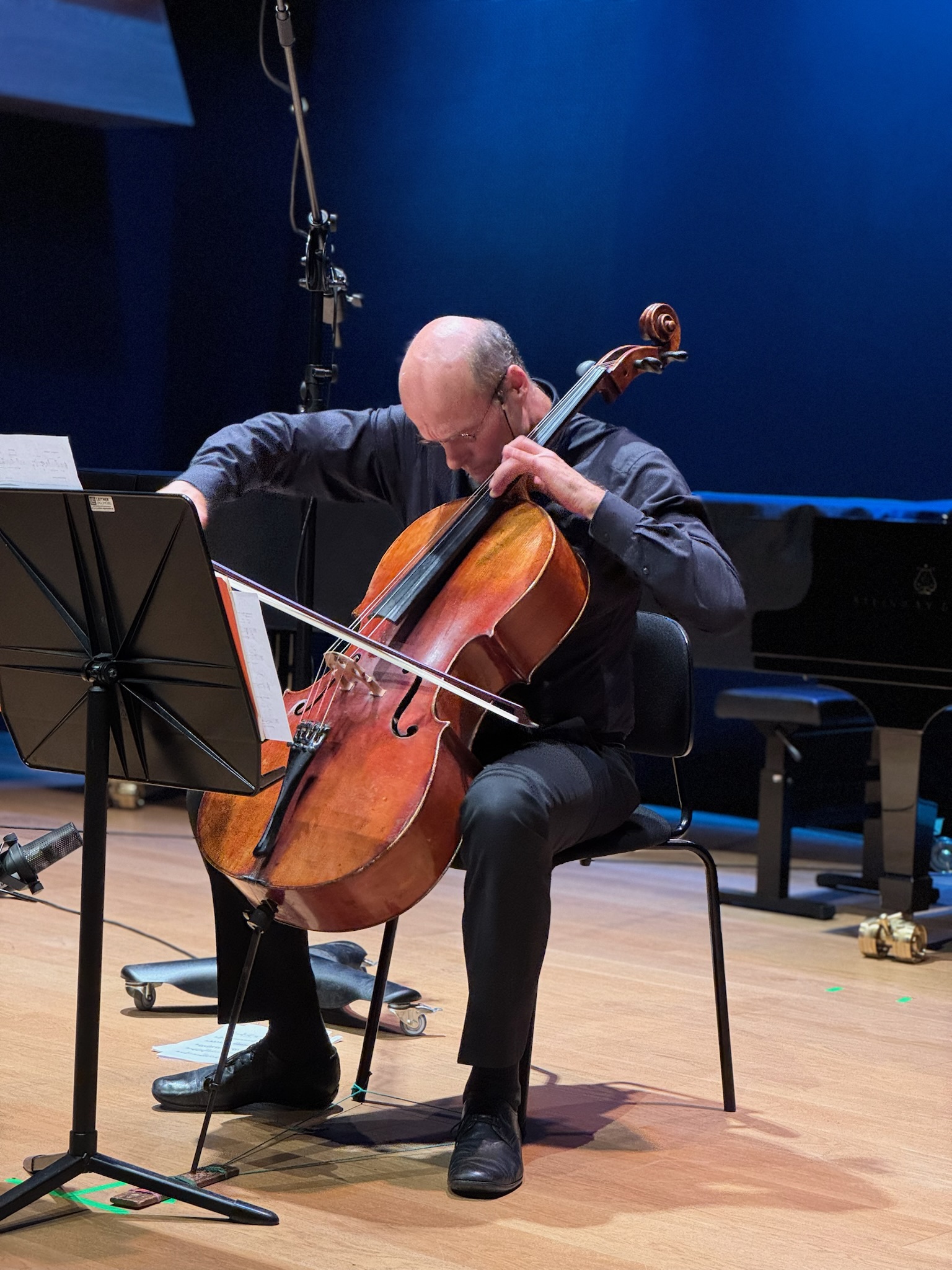
Matthias Lorenz, SONV 2025, photo MJ Báez
Tape and electronics clearly caught very little interest during the festival. Among the resident artists, only Shouye Huang chose to utilise them in A Pier Without Arrival (2025) for piano and tape. Unfortunately, the piece, whose opening bore a lot of natural dialogue between instrument and electronics, quickly dissolved into a multistylistic, slightly messy patchwork. Among the faculty and guests, only Marko Markuš had incorporated a layer of electronic sounds. In his (T)räume Ia for flute and fixed media (2022), the instrument and tape were surprisingly cohesive, sometimes making it difficult to distinguish them, the tape serving as a shadow of the flute. Although during the concert, the electronic layer was a bit too loud at the beginning, the volume was adjusted during the piece, allowing Lamb’s flute to charm the audience with its delicacy and elaborate overtones. His performance shone in Daniel Moser’s El jardin de senderos que se bifurcan (2023), a piece that captivated with its surprisingly clear narrative in an open, segmented form (only the Prologue and Epilogue had had strictly defined positions; the remaining fragments were chosen by the instrumentalist, following a few rules). The dichotomy of sforzatos and fast, shimmering figurations and taps accompanied the dualism of chance and order. The contrasts, at times sharpened, at times smoothed out, the motifs developed or reached a dead end. The piece’s inspiration came from the labyrinth motif in Jorge Luis Borges’s stories. I had this pleasant feeling, however, that the composer had lent me a map for the duration of the piece.
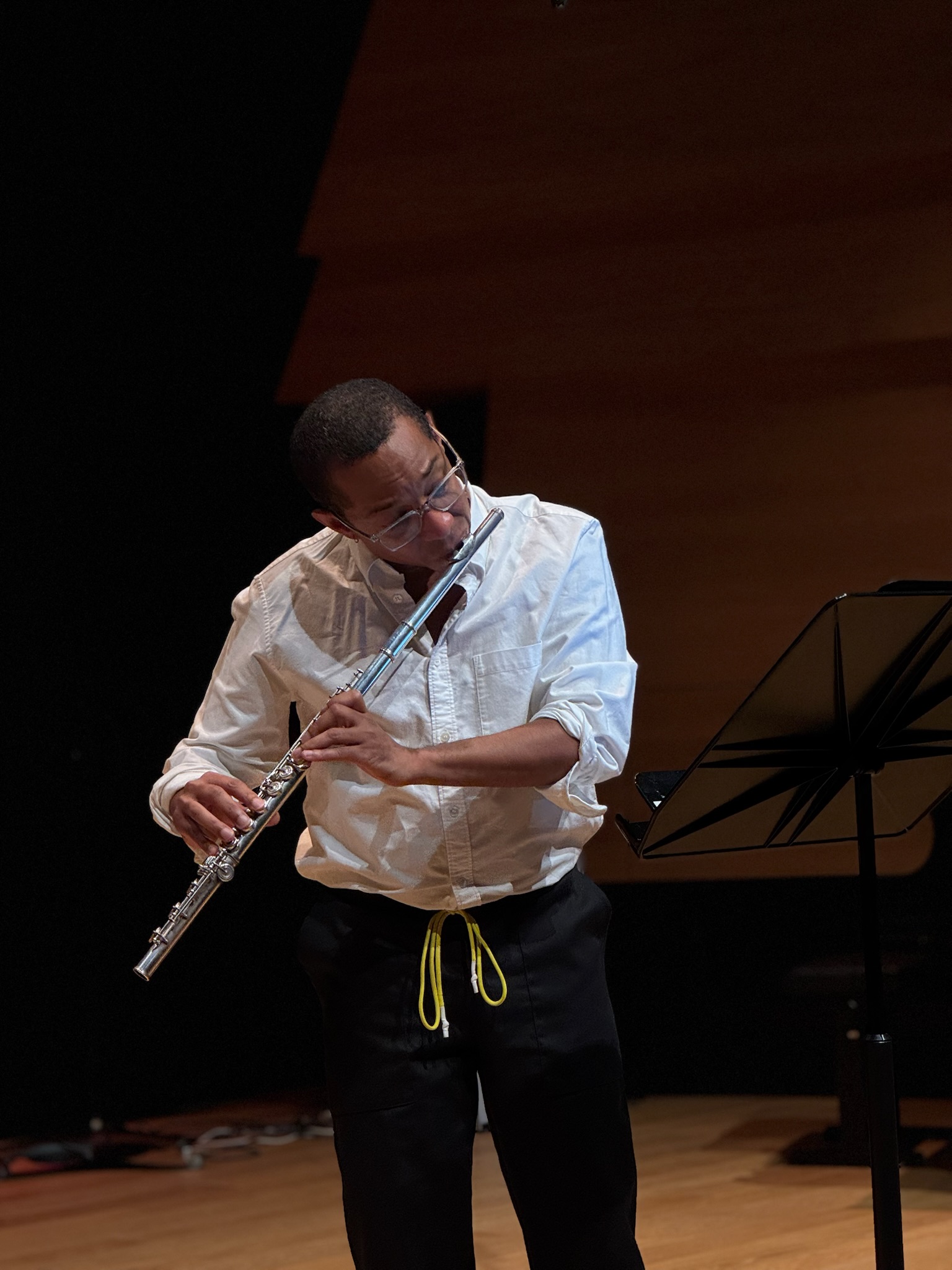
Eric Lamb, SONV 2025, photo MJ Báez
An exceptionally logical narrative was also constructed by Lukas Ligeti in Entasis (2023) for string quartet (again – fantastic Mivos) from minimal and simple musical material – the microtonal scale progressions. The word entasis denotes a bulge, a protrusion, used, for example, in constructing columns to avoid the impression of narrowing towards the top. Ligeti created not visual but rhythmic illusions – seemingly complex arrangements that result from the interlocking and overlapping of relatively regular rhythms.
Víctor Báez also limited his musical building blocks in his Mikropornographie for piano. The enigmatic title, a play on words, suggests voyeurism of precision, virtuosity as the added show to music, parallel to this in pornography, to physical love. Both being empty and unreal. The consistency in sticking to the initial means and the almost persistent repetition created a micro-scale saturation in the piece. In the empty space of fifths, there was a huge density of seconds in rapid figurations. All this spread on a blurring, long pedal, and superbly executed by Ian Pace. The graceful ending particularly caught my attention – the last few bars are an aesthetic and formal summary of all the musical ideas condensed into a short motif. Another allusion to pornography?
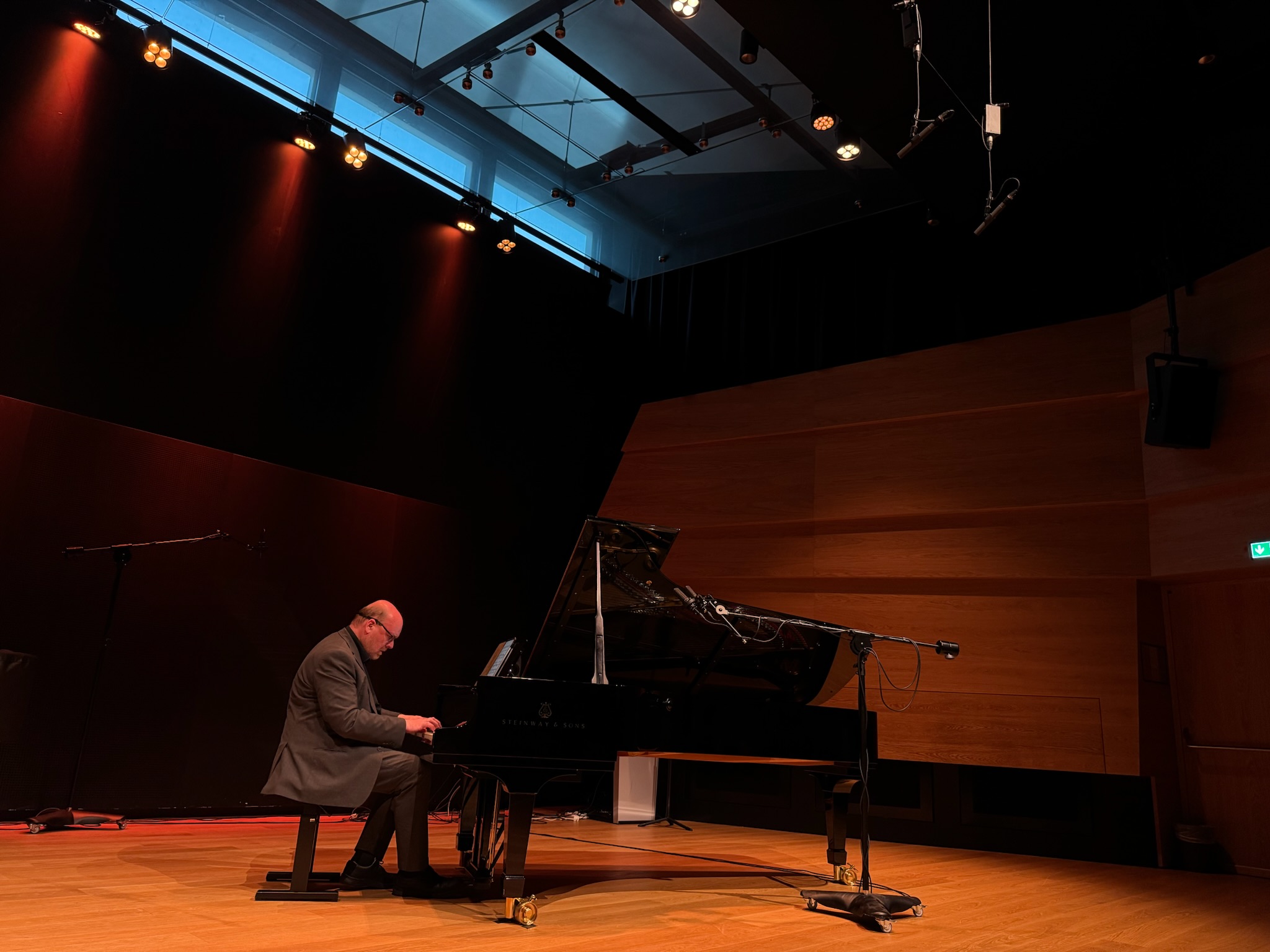
Ian Pace, SONV 2025, photo MJ Báez
Unlike the two previous pieces, Dai Fujikura’s Pitter Patter (2016) for violin and piano was much more free-form. Shimmering yet gentle, it operated with delicate contrasts – segments of figuration and trills on a long pedal interspersed with sharper accents and articulations, explorations of timbre, or heavier, more grounded sounds. And while it didn’t captivate me as much, it was pleasant to listen to. On the other hand, Adrián Artacho’s Ricercar (2025) was more challenging to comprehend. A work in constant motion, searching, full of motifs that reach dead ends, left me feeling that listening to it once was definitely not enough to understand the complex stream-of-consciousness-like narrative.
Now and Tomorrow
Putting two generations of composers side by side in the program allowed me to notice that while working on a piece and developing the craft, certain movements between Yesterday, Now, and Tomorrow occur, both on a micro and macro scale. From expanding the initial ideas with a limited work with structure, towards limiting the ideas and expanding the structure. Increased focus on the conceptual framework. From a multitude of ideas to the consistent development of a specific one. Moving away from their quantity and toward their development. From unfettered intuition to more careful planning. To what extent are certain elements related to the natural development of musical language and education, and to what extent are we ready to automatically categorise them, blindly and without thought, under the label of youth? Observing the process and participating in hours of discussions with residents, lecturers, and performers significantly aided my attempts at understanding these relations. Any approach to listening to the music of artists who begin their journey Now requires considerable attention, sensitivity, and an open mind.
And ear.
Similarly inspired by the process of musical education is Lena Michajłów once again (2025). ↩
Landay – ancient form of folk, oral, anonymous poems typical for Afghanistan. The quote used by Bulatova is from the titular landay from I Am the Beggar of the World: Landays from Contemporary Afghanistan, a collection of poems by Afghan women issued by Farrar, Straus and Giroux in 2014. ↩



